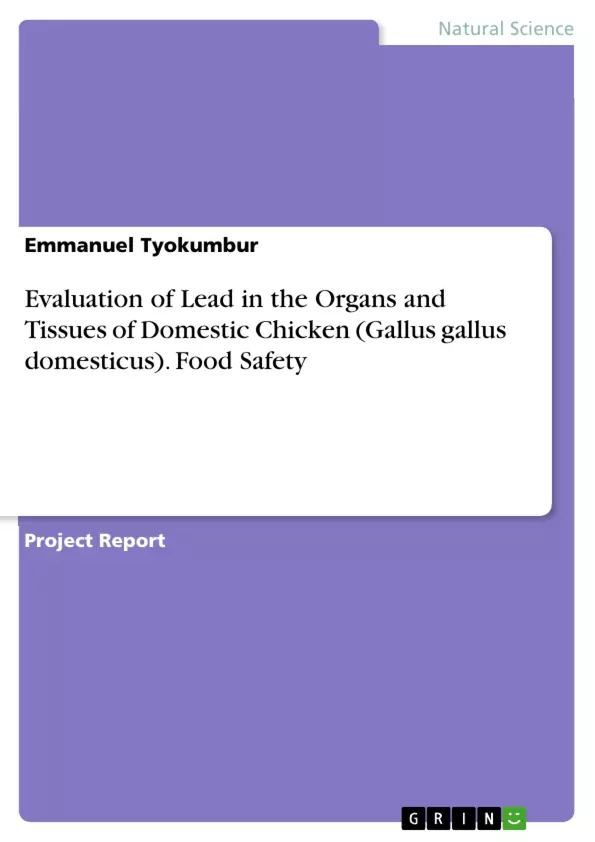A study was carried out on the assessment of lead in the organs and tissues of domestic chicken (Gallus gallus domesticus) in Ibadan from August to September 2015. Ten (10) chickens (layers and broilers) expressed as samples 1-10 were purchased from different retailer markets (Bodija, Ojoo and Sango) within Ibadan City. The chickens were dissected to remove the intestine, liver, kidney, blood, feathers and muscles were oven-dried at 220 degree Celsius. The pulverized organ and tissues samples were acid-digested and analyzed for the heavy metal lead (Pb) using Buck Scientific Atomic Absorption Spectrophotometer (AAS). The results showed that the highest Pb concentrations in parts per million (ppm) were recorded in the liver (2.940+0.040), intestine (3.9800+0.500), kidney(3.6600+0.6000), feather (3.5900+0.06000), and muscle (3.400+0.4000) in sample 10, while the lowest concentration was recorded in the kidney (0.150+0.0300) in sample 1 all at Bodija Market . Analysis of Variance (ANOVA) revealed significance of the Pb metal in the organs and tissues of chickens at P< 0.05. Less than half of the samples had Pb concentration that exceeded the permissible limit of 0.1ppm set by FAO/WHO.
Table of Contents
- 1.0 INTRODUCTION
- 1.1 AIM OF THE STUDY
- 1.2 OBJECTIVE OF THE STUDY
Objectives and Key Themes
The study aims to assess the lead (Pb) concentration in chicken organs consumed in Ibadan City, Nigeria. It aims to determine the distribution of Pb in various tissues, including muscle, liver, intestine, kidney, blood, and feathers. The study further seeks to compare the obtained results with permissible limits set by international bodies and to evaluate the potential health risks associated with Pb accumulation in chicken meat.
- Lead (Pb) concentration and distribution in chicken tissues.
- Comparison of Pb levels with international permissible limits.
- Potential health risks associated with Pb accumulation in chicken meat.
- Food safety implications of Pb contamination in chicken meat.
- The role of industrialization and urbanization in heavy metal pollution.
Chapter Summaries
- Chapter One: Introduction This chapter provides an overview of the study's background, including the problem of heavy metal pollution in developing countries, the sources of lead contamination, and the potential health risks associated with lead exposure. It also highlights the significance of poultry meat in human diet and the importance of ensuring its safety.
Keywords
This research focuses on the bioaccumulation of lead in domestic chicken organs and tissues, specifically examining the concentration and distribution of the heavy metal in various parts of the bird. The study utilizes analytical techniques to assess the levels of lead in tissues including muscle, liver, intestine, kidney, blood, and feathers. These findings are then compared with established international permissible limits to evaluate the potential health risks associated with consuming contaminated chicken meat.
- Quote paper
- Emmanuel Tyokumbur (Author), 2015, Evaluation of Lead in the Organs and Tissues of Domestic Chicken (Gallus gallus domesticus). Food Safety, Munich, GRIN Verlag, https://www.hausarbeiten.de/document/1363592


